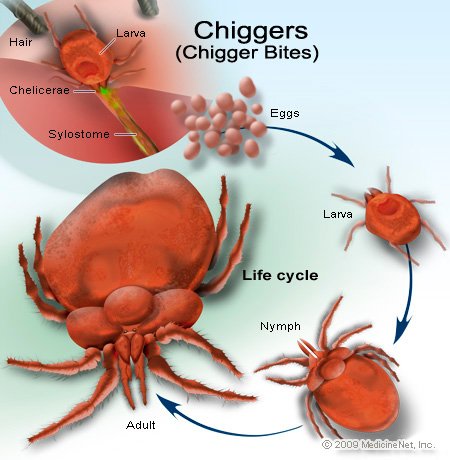If you have ever come in from being outdoors all day and found hundreds of small itchy welts on your ankles, you may have been eaten up by chiggers! These microscopic little insects knows as “chiggers” are actually the immature larva stage of mites belonging to the family Trombiculidae. Interestingly, chiggers are more closely related to spiders than to insects, belonging to the class Arachinida, along with scorpions and ticks.
Chiggers, like ticks live outdoors in vegetation-shaded soil. They similarly go through four life stages: egg, larva, nymph and adult. Adults spend the winter in the soil and first thing in the spring when the temps start to rise, females deposit their eggs in leaf litter and damp soil. Larva that hatch out have six legs, are yellowish to light-red, and measure 0.15 to 0.3 mm in diameter. Only the chigger larva are parasitic. These larva are virtually invisible, but you you will feel their effect!
Once a larva finds a host, it typically feeds for 3 days before dropping off to digest its meal and molt into its next life stage. This is why you want to protect yourself before you go out. SickTick Ankle Bands are highly effective at keeping these larva from finding their way to your exposed skin.
Nymphs and adults have eight legs and are predators, fortunate for us, they feed on small insects and insect eggs found in the soil. Adult Eutrombicula mites are about 1 mm long, with a velvety texture and brilliant red coloring. They are sometimes seen walking in leaf litter or along the edges of stones or concrete, they stand out due to their red coloration.
You can find chiggers throughout the world, but they are most common in the south, southeast, and the midwest in the US. Their preferred temperature range is from 77 to 86 degrees Fahrenheit, and they die when temperatures fall below 42 degrees.
Chiggers are most active from late spring to fall across Texas and surrounding states, and given the right conditions, they may remain active year-round where they can produce up to four generations per year!
Several species of chiggers occur in Texas, but only two are troublesome
Eutrombicula alfreddugesi generally inhabit disturbed grassy and weedy upland areas and may be encountered in overgrown briar patches and along the edges of wooded areas. The other species, Eutrombicula splendens generally prefer moist habitats such as swamps and bogs, rotten logs and stumps.
Thankfully chiggers in North America are not known as spreaders of disease, like ticks, though in East Asia and the South Pacific there are types of chiggers known to spread a form of typhus. Still, chigger bites are nothing to scoff at, and persistent scratching can open the skin up to possible bacterial infections.
Chiggers prefer birds, reptiles, rodents or other small mammals as hosts, but they do bite humans if given the opportunity. Fortunately, they generally only survive on humans for a day or two due to people’s adverse skin reactions and scratching.
Chiggers hop onto shoes or clothing and typically explore a host for several hours before choosing a place to feed. Chigger bites are most common in areas where clothing is tight or where skin is thinnest, which is why you most often find bites around sock lines on the ankles where socks fit tightly, around the waist and near the groin. Bites also may occur in other areas, including behind the knee and under the armpit.
Chigger bites generally appear around the ankles (photo by Merchant)
Unlike ticks, chiggers pierce the skin with their sharp mouthparts and inject a digestive enzyme, disintegrating skin cells for food. This is why chiggers do not grow in size like ticks once attached. Itching usually begins within 3 to 6 hours after an initial bite, followed by development of reddish areas and sometimes clear pustules or bumps. As the skin becomes red and swollen, it may completely envelop the feeding chigger, making it appear that the chigger has burrowed into the host’s skin. Itching typically peaks at 24 to 48 hours after chigger bites occur, but redness and itching may persist for a week or more for some people.
Defend yourself with SickTick Ankle, Leg and Waist Bands
Adding a pair of SickTick Ankle Bands help keep chiggers off your ankles. Easy on and easy off, they can be used effectively all season long by all members of the family!
The best defense against chiggers is to avoid them, but that’s difficult to do when you work and recreate in chigger-country. Your best best is to wear protective clothing, such as long pants, long-sleeved shirts and shoes or boots when venturing into chigger habitats. To keep chiggers from finding a way in, wear SickTick Ankle Bands around your socked ankle when wearing shows or low boots, this creates an immediate Permethrin barrier they cannot cross. If you wear taller boots, consider SickTick Leg Bands as they fit around boots and calves up to 19” in circumference. Add a SickTick Waist Band above, and you’ll have a clear set of barriers to chigger entry. Avoid sitting or lying directly on the ground if you can. Remove your clothes as soon as possible after exposure to chigger habitats, and wash them before the next wearing.
There’s no better time to protect yourself than now!
Before you head outdoors, consider tick issues in your area and learn about all the tick-borne diseases that you might be exposed to. An ounce of prevention can save you years of frustration and negative effects. Stay safe out there this year!






